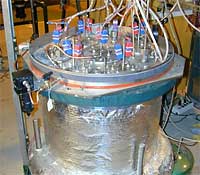Sodium Reactor Experimental Test Facility
The Sodium Reactor Experimental Test Facility (SRETF) is a fully instrumented facility for conducting and observing reaction experiments between moist gases, steam and alkali metals.
|
|
The Sodium Reaction Experimental Test Facility is a facility for conducting reaction experiments between moist gases, steam, and alkali metals. The facility consists of two sections: one section for observing the reaction between humidified gases and alkali metal samples, and another section for observing the reaction between steam, inert or reacting gases, and alkali metal samples. The facility is fully instrumented to record experimental data on system and sample temperatures, system pressures, gas and steam flow rates, supply and exhaust moisture content, hydrogen and oxygen concentration of exhaust gas.
The Sodium Reaction Experimental Test Facility was created as a collaborative effort of the Nuclear Engineering Division and Idaho National Laboratory's Experimental Breeder Reactor Closure Project. The facility was created specifically to observe the reaction between moist carbon dioxide gas and sodium. The Experimental Breeder Reactor is a sodium-cooled fast spectrum reactor that was in the initial phases of being decommissioned. The reactor's sodium had been drained and the Project needed to know how residual sodium would react with moist carbon dioxide. Experimental results led to the successful treatment of the residual sodium. Below are some pictures of the sodium reaction experiment.
The focus of the facility's current efforts is to determine how to control the reaction
between lithium and moist gases and steam/gas mixtures. Future applications will include
the ability to spray wash alkali metal samples with water in various gases to observe the
reaction kinetics and controllability of the reaction process.
![]() Visit
our Photo gallery
Visit
our Photo gallery
Last Modified: Tue, February 16, 2010 11:44 AM




